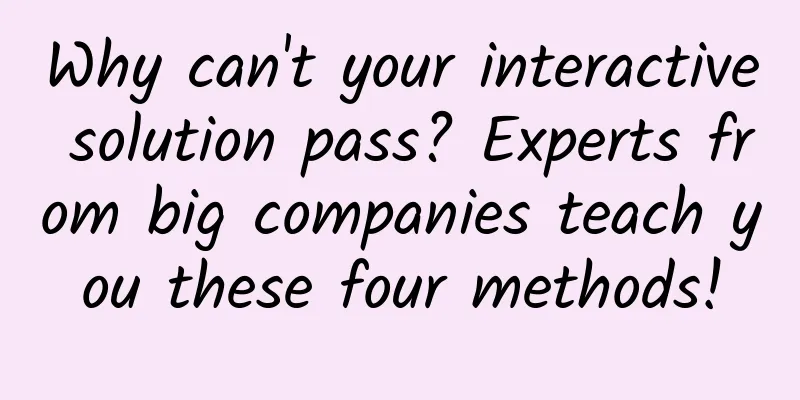Why can't your interactive solution pass? Experts from big companies teach you these four methods!

|
This week, we specially invited Yi Yi, a former senior interaction designer at Baidu, to talk about her process of upgrading from a novice in interaction to fighting monsters. Yi Yi switched from a pure science major to a designer, and from the C-end to the B-end in recent years. She has encountered many pitfalls in job hunting and work, and today she will share some of her experiences. Have you ever had the same experience as me: when we put a lot of thought and confidence into making a highly complete interactive solution, it may be rejected by just a few words from others. Scenario 1When I was confirming the interaction plan with the leader, he completely denied it after I said just two sentences. As a result, I had to return to my workstation and start all over again with the draft that the leader didn't even look at. Scenario 2When confirming the interaction plan with the PM, the PM raised questions again and again and mentioned various ideas A, B, C, D, and E, which led to repeated revisions of my plan and failure to deliver it on time. Scene 3When I proposed my self-driving design to my boss, I failed to get his approval, which resulted in my inability to obtain development resources and the failure of the self-driving project. Scene 4The interviewer from a large company kept asking questions about a project in my portfolio, but I found it difficult to give him satisfactory answers, which ultimately led to the failure of the interview and the loss of the offer. For new designers, having their plans rejected repeatedly is not only time-consuming and laborious, but also makes them doubt their abilities and shake their confidence in entering the interactive world. Today, I will analyze with you what kind of interactive plans cannot withstand scrutiny, and how to present them so that our plans (at least look) are seamless and can withstand repeated questioning and scrutiny from others? The presentation form is important, but the derivation process is more importantDaily chores and job search preparation can make many people forget the essence of interaction design. From the perspective of a visual designer, interaction design is the design of user behavior, which is very different from the visual design that users can intuitively perceive. From a product perspective, interaction design is more inclined to polish behavioral details and user psychology, which is very different from the macro and rough design of the overall product framework. What interaction designers should output is the entire design derivation process: the user's behavioral habits, expected psychology, usage scenarios, pain points, etc. in the operation process, rather than just the final seemingly perfect visual presentation, or the seemingly organized but lacking detailed functional introduction. This point is often overlooked by designers who are new to the industry, non-interactive professionals, or from small companies. The two most common types are as follows: The first type is designers who come from a visual design background and want to switch to interactive design. They often emphasize the proper use of components, clear copywriting guidance, and even the use of novel micro-motion effects in their proposals. These are indeed the design highlights that a good proposal needs; but if the overall proposal lacks a design derivation process and is made based on one's own subjective ideas, then your proposal will naturally be vulnerable. The second reason is that the company is short of staff and has to hire interaction designers who are more product-oriented or campus recruits. They often have better background explanations and solution derivations in their proposals, but the presentation of the proposals is too simplified or too much emphasis is placed on "design thinking". The final presentation is similar to PRD, lacking detailed considerations. There is a principle in design called "beauty is good to use". When a solution is presented in a reasonable form, the audience will naturally give it more patience. Otherwise, why don't you go directly to interview the product manager? Use closed-loop thinking to rigorously introduce your designSo, how to make a design plan that can withstand scrutiny and a rigorous design process? Or what should be emphasized and highlighted in the position of interactive design? I think there are a few tips: 1. Never start with the designNo matter you are defending for a promotion, doing daily communication, reviewing manuscripts within the group, or talking about a project in an interview, as an interaction designer, you should never spread out a design drawing and start talking about the details: what color is here, what the layout idea is there...it's not important. Interactions should always start with the topic of "project goals": What does the PM want to do? What kind of results do they want to achieve? What results do the group or company want? Is the functional solution that the PM has thought of reasonable? Why is this solution worth investing design resources or even technical resources in? What we need to do is goal-oriented design, otherwise the products of aimless design will mostly be hodgepodges. 2. Replace “I feel” with “Users feel”Discovering and identifying user pain points is one of the two most important tasks for interaction designers, and the other is to solve the pain points discovered. Before you start talking about your project, spend a few minutes to introduce your user group to your boss and interviewer. What scenarios do users complete the entire process in? What are their psychological expectations and behavioral habits? Even at this stage, you can string together cold, abstract user data and tell a story that seems like a personal experience: for example, you once discovered how your users use your product, what problems they encountered, and how you solved them. A good user story can make people empathize quickly, and you don’t need to explain to your boss over and over again why you do something - the user wants it in this scenario, it's that simple. 3. Introduce your plans and assumptionsEvery interactive design project is a black box before it goes online. Users may like it or not. Arguments between designers, between designers and bosses, between designers and product managers can never truly verify a problem. Today you may perform well and win the argument, but tomorrow you may not perform well and have to go back and shed tears to revise the manuscript. I think in order to really convince your audience to accept your plan, it is best to directly explain which parts of the design plan are based on deductions and assumptions after introducing the plan: how to evaluate whether the design goals are achieved, how to perform subsequent optimization iterations, and how to formulate data indicators? Of course, this may be difficult for a product line that iterates rapidly or lacks data infrastructure and incubation, but this is the working method of all large companies. 4. Reliable solution outputAll the suggestions mentioned above are for presentations during design presentations. Of course, the iron must be hard to forge, and an interactive draft can withstand scrutiny and questioning, which essentially depends on the output of a complete solution. There are many forms of interactive drafts, the most common of which is the page interaction diagram, which clearly describes the page, operation process, group control status, and boundary conditions for use by students in vision, product, technology, testing, etc. For some complex requirements, it is recommended to do usability testing after the first draft of the plan is output, so that there will be no repeated arguments about the complexity of the plan during the review and approval process. The proof of usability testing is enough to make the final decision. Finally, I summarized the standard time distribution of interaction design: Based on the case, what should we do?Finally, let’s look back at the scenarios at the beginning of the article - I believe now you also know what the problem is and how to solve it. Scenario 1When I was confirming the interaction plan with the leader, he completely denied it after I said just two sentences. As a result, I had to return to my workstation and start all over again with the draft that the leader didn't even look at. Cause of the problem: The plan went astray at the very beginning of the demand analysis phase, without clarifying the goal, which caused all subsequent plans to go astray. Solution: Don’t go into the details of the interaction too quickly. Instead, let your leader understand the essence of the needs clearly. After the cognition is aligned, go deeper and don’t be led astray by the PM’s plan at the time. When discussing the plan, you can use data and other helpful explanations to explain the background and goals clearly so that your superiors can quickly understand the needs. Scenario 2When confirming the interaction plan with the PM, the PM raised questions again and again and mentioned various ideas A, B, C, D, and E, which led to repeated revisions of my plan and failure to deliver it on time. Cause of the problem: Most of these PMs only look at the final presentation and lack consideration of the user behavior logic. They are easily caught up in the details of the interactive draft and cannot make up their minds. What they need is professional advice on user experience to tell them what is reasonable to adopt. Solution: First, synchronize the conclusions of the design research phase to the PM, and tell them that the final solution is due to such and such problems. Avoid uncertain and unprofessional words during communication, such as "I think XXX, maybe XX, it should be like this XX". It is recommended to use "The user is XXXX in the real scene, XXX from the user's psychological level, and the user is accustomed to XXX". Scene 3When I proposed my self-driving design to my boss, I failed to get his approval, which resulted in my inability to obtain development resources and the failure of the self-driving project. Cause of the problem: The boss did not see the urgency and investment-output ratio of doing this. Solution: PPT is very important when promoting a project to your boss. Visualize the research process as much as possible, especially the numbers and conclusions. The plan should be complete, and it is best to cooperate with the visual designer to present the best page effect and use DEMO demonstration. Scene 4The interviewer kept asking questions about a project in my portfolio, but I found it difficult to give him satisfactory answers, which ultimately led to the failure of the interview and the loss of the offer. Cause of the problem: There are probably two problems: 1. The project has not reached a closed-loop design, and a certain link is missing, such as insufficient design research and lack of effect evaluation; 2. The design research conclusions do not perfectly correspond to the design goals and strategies, and the interviewer questions whether the solution is goal-oriented and whether it can solve the problem Solution: Check whether there are any missing links in the entire design process, especially how to select and analyze the data indicators for effect evaluation; check whether the design derivation process corresponds to the final strategy and plan, and the logic must be rigorous. |
<<: Apple's foundry stops production! Global supply chain is impacted
>>: Should iOS use the original version or upgrade to the latest version?
Recommend
A day in the life of a technical manager at Google
[[154079]] I shamelessly wrote this article about...
How to monetize TikTok?
Recently, Tik Tok has become a battleground for M...
The National Day is coming. How can brands leverage this opportunity for marketing?
Bid farewell to Mid-Autumn Festival and welcome N...
How to warm up for event operation and promotion?
A complete event includes four links: preliminary...
Why BAT is a supplier in the automotive field instead of making cars directly? This is actually very wise
With the release of Tencent's autonomous driv...
Webb telescope detects "prebiotic molecules"! Is there really alien life?
Produced by: Science Popularization China Author:...
6 steps to write good soft articles, and you can promote well with little investment
Hello everyone, today I am here to share with you...
The latest news on oil price adjustment on April 15, 2022: How much will it be reduced? Attach details
Since the beginning of this year, oil prices in m...
China Association of Automobile Manufacturers: Economic Operation of the Automobile Industry in October 2024
In October 2024, my country's automobile prod...
Are melamine and clenbuterol food additives? Can we eat additives?
When it comes to food additives, people have grad...
Kuaishou Operation: Inventory of techniques to increase followers!
How to operate Kuaishou and increase followers qu...
Use these 6 tricks to create a fission activity with over 100,000 followers!
When we are doing various marketing fission activ...
With a "click", the orthopedic surgeon broke his own bone
Recently, an orthopedic surgeon in Henan Province...
How does a tiny virus with a diameter of less than 120 nanometers carry out its "T cell attack plan" in the human body?
On June 5, 1981, the U.S. Centers for Disease Con...
How to design a product points system from 0 to 1?
The points system connects users and products, wh...




![[Buy the right car] The most comprehensive car buying guide in history, helping you avoid scams and save money](/upload/images/67cc12948f256.webp)




